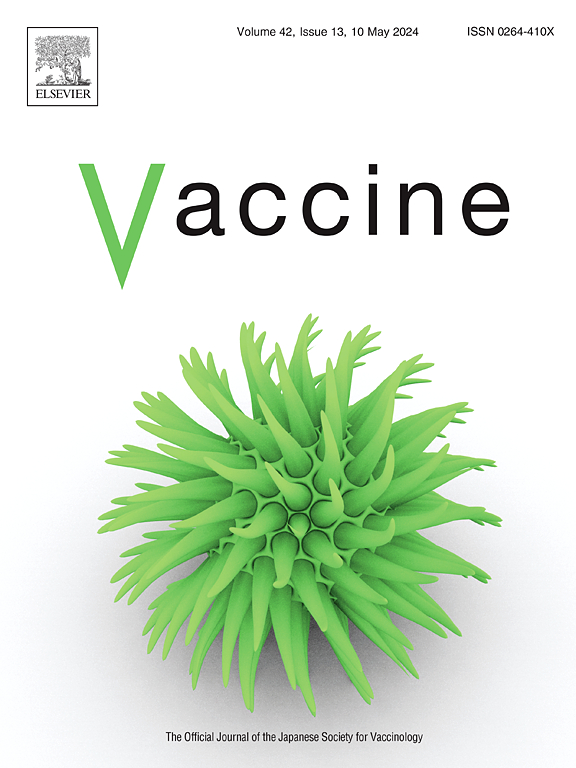Did inequalities in COVID-19 vaccination resolve over time? Insights from the Canadian Community Health Survey
IF 4.5
3区 医学
Q2 IMMUNOLOGY
引用次数: 0
Abstract
Introduction
Disparities in COVID-19 vaccination coverage emerged during the vaccination campaign. This study aimed to assess whether inequalities in COVID-19 vaccination coverage in Canada persisted or resolved throughout the vaccine rollout.
Methods
Using data from the Canadian Community Health Survey, the analysis included people 18 and older from all ten provinces. Vaccination coverage for at least one dose of a COVID-19 vaccine was determined in three periods: June 2021–February 2022 (n = 28,182), February–June 2022 (n = 25,742), and July–December 2022 (n = 23,119). Statistically significant gaps across groups were assessed using non-overlapping 95 % confidence intervals (CI).
Results
In June 2021–February 2022, coverage for at least one dose (95 % CI) was 85.5 % (79.0–90.3) for off-reserve First Nations people, 85.7 % (79.6–90.1) for Métis people, 79.6 % (72.1–85.4) for Black people, 83.0 % (72.9–89.9) for Arab people, and 92.9 % (92.3–93.5) for White people. By July–December 2022, coverage was 87.4 % (80.2–92.3), 90.5 % (85.5–93.8), 92.1 % (87.2–95.2), 95.6 % (90.6–98.0), and 95.1 % (94.5–95.6), respectively, in the same populations. The gap between off-reserve First Nations and White people remained significant, at 7.4 percentage points (pp.) in the first period and 7.6 pp. in the third period. As for Métis and White people, the gap decreased from 7.3 pp. to 4.6 pp. In the first period, the gap compared to White people was 13.4 pp. for Black people and 9.9 pp. for Arab people, and resolved in the third period. Significant gaps also remained across age groups, levels of educational attainment, household income, for those residing in rural areas, those living with children under 12 years old, and those without a regular healthcare provider.
Conclusion
Despite efforts to address them, several inequalities persisted throughout the vaccine rollout, underscoring the need for refined strategies to reach all population segments. As Canadian vaccination registries do not collect sociodemographic data beyond date of birth, sex and place of residence, survey data is needed to measure these disparities.
COVID-19疫苗接种的不平等是否随着时间的推移而消除?来自加拿大社区健康调查的见解
在疫苗接种运动期间,COVID-19疫苗接种覆盖率出现了差异。本研究旨在评估加拿大COVID-19疫苗接种覆盖率的不平等是否在疫苗推广过程中持续存在或得到解决。方法使用来自加拿大社区健康调查的数据,分析了来自所有10个省的18岁及以上的人群。在三个时期确定至少一剂COVID-19疫苗的接种覆盖率:2021年6月至2022年2月(n = 28,182), 2022年2月至6月(n = 25,742)和2022年7月至12月(n = 23,119)。使用非重叠95%置信区间(CI)评估各组间的统计学显著差异。结果2021年6月至2022年2月,非保留地原住民至少一剂疫苗的覆盖率(95% CI)为85.5% (79.0 ~ 90.3),msamutis人群为85.7%(79.6 ~ 90.1),黑人为79.6%(72.1 ~ 85.4),阿拉伯人为83.0%(72.9 ~ 89.9),白人为92.9%(92.3 ~ 93.5)。到2022年7 - 12月,同一人群的覆盖率分别为87.4%(80.2-92.3)、90.5%(85.5-93.8)、92.1%(87.2-95.2)、95.6%(90.6-98.0)和95.1%(94.5-95.6)。保留地外的原住民和白人之间的差距仍然很大,第一个时期为7.4个百分点,第三个时期为7.6个百分点。黑人和白人的差距从7.3 pp缩小到4.6 pp。在第一个时期,黑人和白人的差距为13.4 pp,阿拉伯人的差距为9.9 pp,在第三个时期,这一差距消失了。对于居住在农村地区的人、与12岁以下儿童一起生活的人以及没有正规保健提供者的人来说,各年龄组、受教育程度、家庭收入之间也存在巨大差距。结论尽管努力解决这些问题,但在疫苗推广过程中仍然存在一些不平等现象,这突出表明需要改进战略,以覆盖所有人群。由于加拿大疫苗接种登记处不收集出生日期、性别和居住地以外的社会人口统计数据,因此需要调查数据来衡量这些差异。
本文章由计算机程序翻译,如有差异,请以英文原文为准。
求助全文
约1分钟内获得全文
求助全文
来源期刊

Vaccine
医学-免疫学
CiteScore
8.70
自引率
5.50%
发文量
992
审稿时长
131 days
期刊介绍:
Vaccine is unique in publishing the highest quality science across all disciplines relevant to the field of vaccinology - all original article submissions across basic and clinical research, vaccine manufacturing, history, public policy, behavioral science and ethics, social sciences, safety, and many other related areas are welcomed. The submission categories as given in the Guide for Authors indicate where we receive the most papers. Papers outside these major areas are also welcome and authors are encouraged to contact us with specific questions.
 求助内容:
求助内容: 应助结果提醒方式:
应助结果提醒方式:


